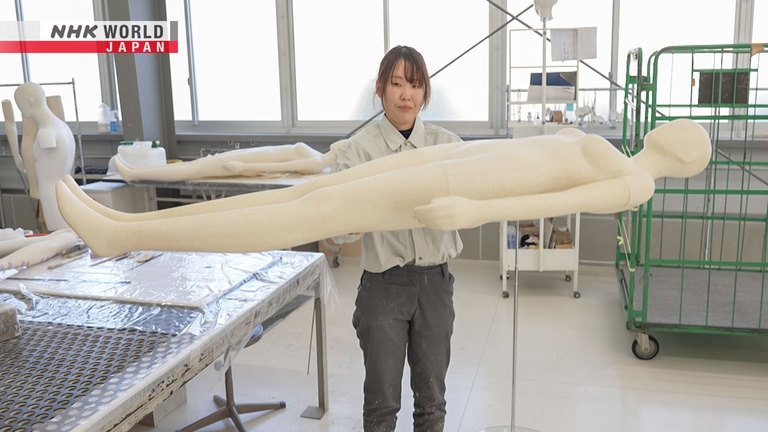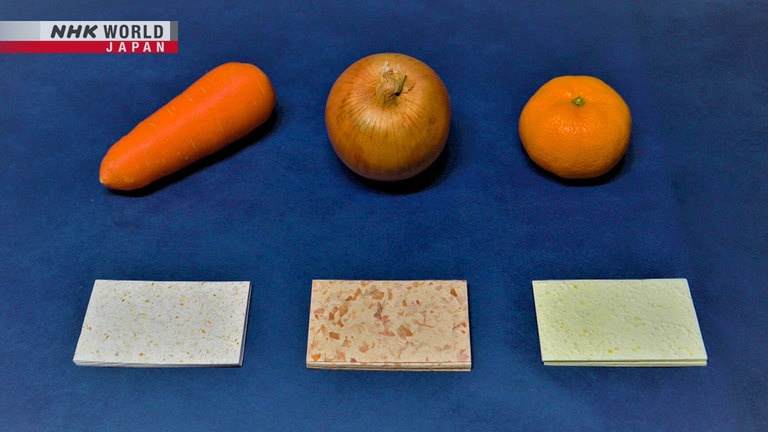Washi: The Ultimate Multi-Purpose Paper
[SPECIAL EDITION]
This series includes selected stories from BIZ STREAM's signature "On-Site" reports. In addition to writing paper, traditional Japanese washi paper has long been used in a variety of ways, such as for making lamp shades and door and window screens. This episode looks at how some companies are taking the ancient material into the future through even more sustainable production methods and creative new applications.
*Subtitles and transcripts are available for video segments when viewed on our website.
Washi: The Ultimate Multi-Purpose Paper

Weighing approximately 80% less than a standard plastic version, a mannequin made from washi paper can be easily carried by just one person

Using discarded fruits and vegetables allows for a more eco-friendly product and results in paper that offers different color and strength options depending on which types of produce were used to make it
Transcript
"Washi" has a history dating back more than 1,300 years.
One company is using the traditional Japanese paper as an alternative to plastic, for producing mannequins.
And a washi maker is now using vegetable waste to create various new types of paper.
Today's On-Site Report shows how some washi makers are using the unique attributes of the traditional paper,
to create new products that will carry their craft into the future.
The brown and orange specks you see are tiny pieces of onion peel, that have been added to create a new type of washi.
By using carrots, tangerine peels, or other fruits and vegetables, washi can be made with differing characteristics.
This produce-enhanced paper is made by fourth generation Echizen washi maker, Igarashi Masami.
With demand for washi in decline, her business has seen sales drop nearly 50 percent over the last two decades.
With business as bad as it's been, I knew we had to try something different, or we'd be at real risk of going under.
Just as she was thinking about how to update her product lineup, her son Yuto provided some unexpected assistance.
When he was a fourth grade elementary school student, he decided to try making paper from regular vegetables,
like cabbage and onions for his summer vacation homework assignment.
I was really excited to try out different kinds of vegetables, and then see what kinds of paper they would turn into.
Even after the assignment was finished, he continued his experiments,
testing and documenting the properties of paper made from 30 different kinds of fruits and vegetables.
Each of type of produce offers unique characteristics, while still functioning as a useful ingredient for making a solid paper.
I'm amazed at how creative children can be!
In 2019, Masami used Yuto's research as a springboard, and began applying the concept to making washi.
Because fruits and vegetables have fibers of different strengths and thicknesses,
it took a lot of trial and error for Masami to figure out the ideal ratios needed to create quality washi.
The result? A variety of washi,
each with the unique colors and textures of the corresponding fruits and vegetables, that were used to make them.
I was both surprised and happy to realize that something I had just started as a homework assignment,
would actually end up becoming a product for our family's business!
The produce used for making the washi comes from waste collected from local businesses.
This processing plant alone produces over 500 kilograms of vegetable waste per day!
We were thrilled to find out that something we contributed is being used by a traditional Echizen washi maker!
With testing complete, Masami's company began making and selling its own products made from vegi and fruit-based washi, such as bags and storage containers.
Soon after, other businesses began asking Masami to make similar items for them using their own waste products,
like packaging made with tea leaves, and business card holders made from paper containing herbs.
Masami expects her new produce-based products to make up more than half of her company's sales by 2025.
It's important that the next generation of washi makers be taught our traditional paper-making methods,
as well as how to innovate and create new types of washi.
That's the best way to increase its appreciation not just among people here in Japan, but all around the world.
These special mannequins first debuted in December of 2021.
Each one is made almost entirely of washi.
Standard full-size mannequins made of fiberglass reinforced plastic usually weigh around eight kilograms.
The new washi mannequins, however, are 80 percent lighter, at just 1.6 kilograms.
They were created by professional mannequin maker, Iwashita Hisaoki.
He knew that more environmentally friendly options than plastic were in demand, and that in the past,
mannequins in Japan were made from a material that is quite close to washi.
Up until about sixty or seventy years ago, most mannequins here were made by filling molds with paper-pulp;
so I thought, why not try doing the same thing with washi?
Currently, most of his company's mannequins are made from fiberglass reinforced plastic.
They are made by adding a coating of resin over fiberglass cloth, that is fitted tightly over a mold.
When making a washi mannequin, nine separate layers of wet washi are evenly placed over the necessary molds.
After drying, the surface of the paper is carefully compressed by hand.
This not only increases the strength of the washi, but results in a smooth and beautiful finish.
After removing the different body parts from their molds,
the remaining open portions are covered with washi, and the mannequin is ready to be put together.
The washi used for the mannequins is made by Kikuchi Daisuke.
He makes washi using the Nishinouchi technique, which is registered as an intangible cultural asset by Ibaraki Prefecture.
Even for an expert, making washi that is suitable for use in mannequins proved to be quite challenging.
Each piece of handmade washi usually differs both in thickness and in weight.
In order for washi to be useable in making a mannequin, which requires uniform strength,
each strip of paper must be weigh between 20 to 23 grams.
When making washi using the traditional method, Kikuchi must carefully assess its density using only his eyes and hands.
I produce up to 250 sheets per day, so making sure that they all fit within such a strict margin of error can be pretty difficult!
Thanks to Kikuchi's skill, the first batch of mannequins was successfully completed.
They made their debut at a major department store in Tokyo.
Not only do they provide us with a more environmentally-friendly option than standard mannequins do,
they are light and are easy for our staff to carry, so they will also help to increase efficiency.
Next, Iwashita hopes to try making mannequins in a variety of different shapes and sizes,
and because they're extremely light weight, he thinks they can be posed and placed in creative ways.
In total, we are currently renting about 15,000 standard mannequins.
Within the next three years, I hope to replace 10 percent of them with washi mannequins.
When I first saw the completed mannequins, I was really surprised at how light and strong they were.
I hope I can continue to create new and different products, that can help raise awareness about washi,
and make people realize how special of a material it truly is.